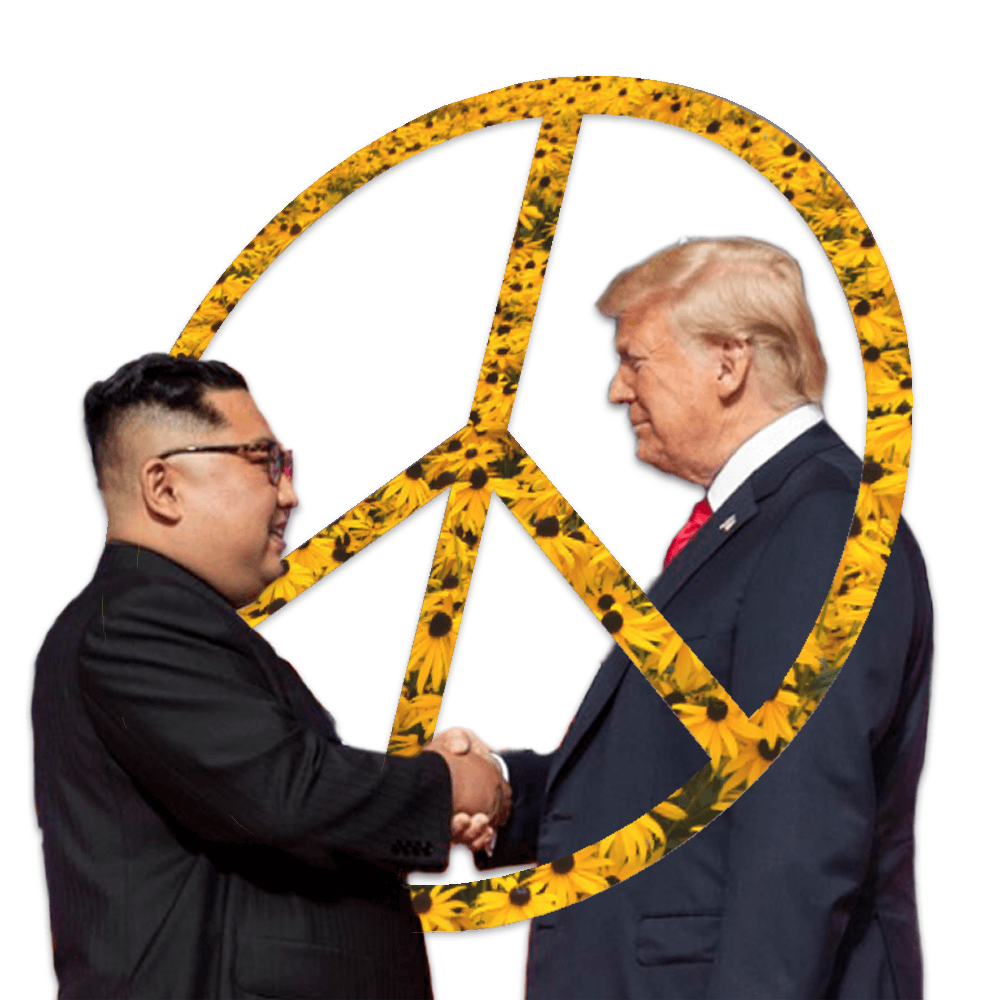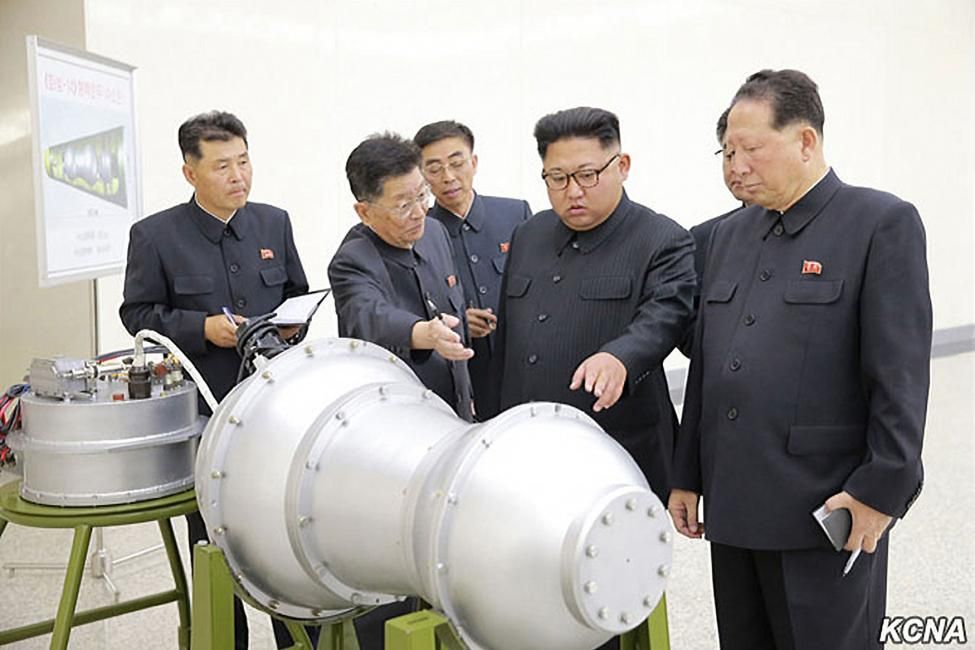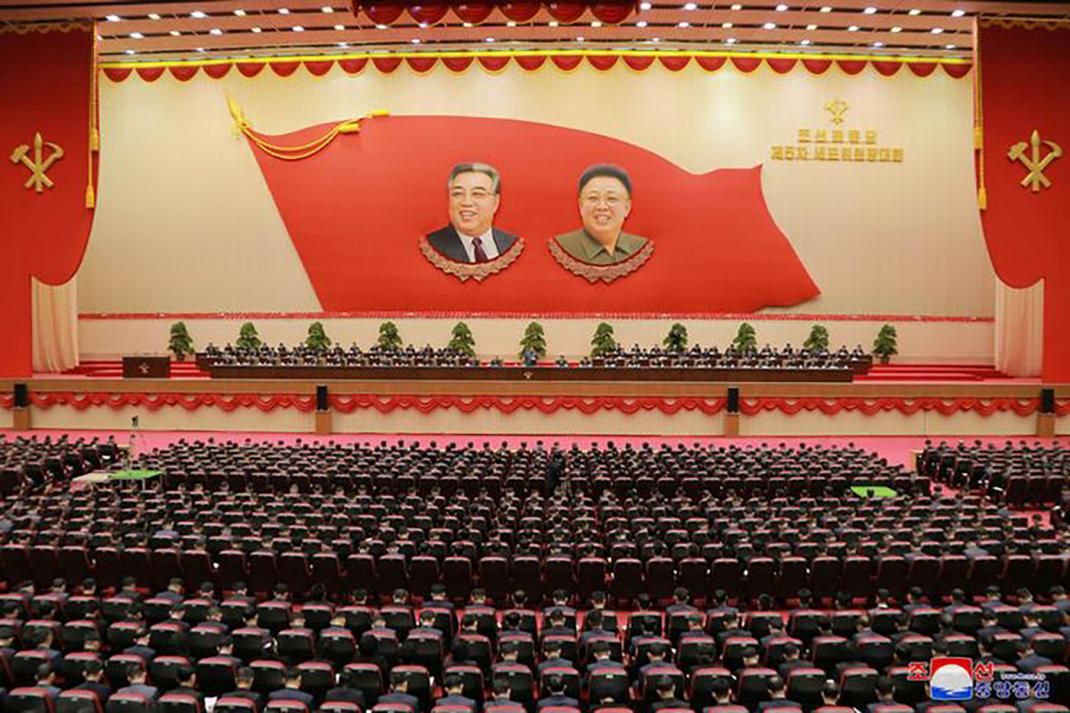Denuclearization of the Korean Peninsula begins with a peace declaration
By David Kim | February 14, 2019
 Illustration by Matt Field. Based in part on photo by Alias 0591 CC BY 2.0.
Illustration by Matt Field. Based in part on photo by Alias 0591 CC BY 2.0.
During his State of the Union address, President Donald Trump announced that he will meet with North Korean leader Kim Jong-un at the end of the month to continue a “historic push” for peace on the Korean Peninsula. If one statement stood out from Trump on North Korea, it’s that “much work remains to be done” to achieve complete, verifiable, and irreversible denuclearization on the Korean Peninsula.
Last year’s summit in Singapore between Trump and Kim was historic not for what it achieved on denuclearization, but for what it signaled to the world: Both countries, through the top-down, personality-driven diplomacy of their leaders, are ready to transform their relationship by seeking permanent peace on the Korean Peninsula. The central question moving forward isn’t whether Kim is willing to give up his nuclear weapons; rather it’s whether the United States and North Korea can transform their relationship to a point where Kim and his elites begin to believe their regime can survive without nuclear weapons. More than any other measure, an end-of-war declaration between the two countries would represent the beginning of this transformation. As the State Department’s special representative for North Korea, Stephen Beigun, said in a speech at Stanford University, “President Trump is ready to end this war. It is over. It is done.” Both sides appear ready to make that statement a reality.
Denuclearization is a long-term goal. While some Trump administration officials have suggested otherwise, complete denuclearization isn’t a realistic short- or medium-term goal. After the Singapore summit, President Trump tweeted that North Korea no longer poses a “nuclear threat.” In fact, experts believe that tweet is a decade or more away from being true. It now seems that Trump may have adjusted his views on this point. In a recent tweet, Trump said he looks forward to “advancing the cause of peace” at the next summit in Vietnam, suggesting he accepts that peace and a new relationship should undergird any real denuclearization agreement with North Korea.
Just landed – a long trip, but everybody can now feel much safer than the day I took office. There is no longer a Nuclear Threat from North Korea. Meeting with Kim Jong Un was an interesting and very positive experience. North Korea has great potential for the future!
— Donald J. Trump (@realDonaldTrump) June 13, 2018
Just landed – a long trip, but everybody can now feel much safer than the day I took office. There is no longer a Nuclear Threat from North Korea. Meeting with Kim Jong Un was an interesting and very positive experience. North Korea has great potential for the future!
— Donald J. Trump (@realDonaldTrump) June 13, 2018
Trump should understand that by agreeing to a peace declaration with the North, he won’t necessarily speed up the denuclearization timeline; rather, he’d be laying the foundation for a formal peace regime, an institutional set-up to allow both the United States and North Korea to work toward that goal. At Stanford, Biegun said the United States is prepared to take parallel steps with North Korea by “simultaneously look[ing] for ways to advance a more stable and peaceful, and ultimately, a more legal peace regime on the Korean Peninsula,” one that can “advance denuclearization.” This is a much more subtle formulation than the previous all-or-nothing approach taken by many US policymakers, the idea that North Korea had to abandon all its weapons first before the United States took any steps such as sanctions relief.
Kim wants an end to the Korean War. Ever since the days of Kim’s grandfather Kim Il Sung’s regime, North Korea has sought a formal peace regime ending the Korean War. The country has repeatedly raised its strong desire for an end-of-war declaration as the next step towards permanent peace. A report on the regime’s state-run news agency, for instance, stated last year “that the issue of the end-of-war declaration should have been resolved a half a century ago.” Trump appears to agree. He reportedly told Kim in Singapore that he’d sign a declaration. Such a peace declaration may serve as a preliminary security guarantee, or litmus test, to see how serious Kim is about denuclearizing.
Unlike a formal peace treaty, an end-of-war declaration, or peace declaration, is a legally non-binding instrument. Getting to a declaration won’t involve difficult negotiations. The document, rather, would represent a symbolic end to a war that has actually been over since 1953. Without abandoning the goal of a peace treaty, Trump could use a declaration to signal to Kim that the United States is serious about negotiating with his regime. As some experts also point out, an end-of-war declaration could be a “game changer” for North Korea because it could help “neutralize the hardliners” within Kim’s regime, creating the breathing space to allow further progress towards denuclearization. It would also counteract the frequent propaganda narrative in North Korea of foreign encroachment.

Some critics fear that a peace declaration will validate North Korea in the eyes of the international community. In reality, however, Kim got all the cover he sought in Singapore. A greater concern is North Korea’s desire to be recognized as a de facto nuclear state. Down the line, the United States should demand that as part of a formal peace treaty, North Korea rejoin the Nuclear Nonproliferation Treaty, enact International Atomic Energy Agency safeguards, and ratify the Comprehensive Test Ban Treaty.
Last July, the North Korean Ministry of Foreign Affairs declared that “the issue of announcing the declaration of the end of the war at an early date…constitutes a first factor in creating trust between [North Korea] and the [United States].” Kim has hinted that China could be involved in negotiations over a peace declaration, something Chinese President Xi Jingping appears to support. Xi’s support could give Kim added incentive to denuclearize. It may also help silence his critics at home. As North Korea continues to press for a peace regime, the United States should use a peace declaration to test Kim’s commitment to denuclearization.
A peace declaration wouldn’t harm the United States-South Korea relationship. Kim Yong-chol, a top negotiator for the North, reportedly told Trump in Washington that his country wouldn’t “demand the withdrawal of US troops in South Korea” as part of a peace settlement. South Korean President Moon Jae-in said he and Kim Jong-un agreed that “an end-of-war declaration would not affect the presence of US troops” on the peninsula. The United States should demand that any peace declaration is explicit and non-negotiable on this point.
From the US perspective, China poses a longer-term threat to security in Asia than North Korea does. For 65 years the United States has projected power and influence in the region through a mutual defense treaty with South Korea. Not only has the treaty kept South Korean nuclear ambitions in check, but the partnership between the countries has expanded well beyond military cooperation. The newly revised United States-Korea Free Trade Agreement and ongoing educational and cultural exchanges are just a few examples of this.
Congress is also playing a role in ensuring that the peace process with the North doesn’t undermine the United States’ relationship with South Korea. The new National Defense Authorization Act prohibits troop reductions under 22,000 unless the secretary of defense certifies that further cuts are necessary for US national security and won’t significantly undermine the security of allies such as Japan. Congress further underscored its deliberate approach to negotiations with North Korea by passing the Asia Reassurance Initiative Act. The law sets out stringent reporting requirements for negotiators to meet by the end of March, including an assessment of the roadmap for denuclearization, a summary of US policies and strategies, and a delineation of North Korean responsibilities. The United States and South Korea also completed a Special Measures Agreement on troop cost-sharing, further ensuring stability during a critical year of diplomacy.
Getting a peace settlement is good politics. Moon, Trump, and Kim each have strong incentives to pursue permanent peace at the Vietnam summit. For South Korea’s Moon, it would help improve his country’s burgeoning relationship with the North and pave the way for a formal peace treaty. For Kim, a peace declaration would further validate his regime and make a war with the United States less likely. For Trump, it would pave the way for real denuclearization efforts on the peninsula.
Moon, whose parents fled North Korea to escape communism, is a seasoned hand at dealing with the North. As a top official in former President Roh Moo-hyun’s administration, Moon made the relationship between the two Koreas a top priority. Roh, of course, presided over the last inter-Korean summit in 2007. For Moon, a peace declaration would help silence his vocal critics and help deflect attention from the country’s economic woes.
In Kim’s speeches–including last year’s address to the Workers Party of the Korea Central Committee and in a New Year’s address–he has taken to emphasizing his focus on economic development–his declared “new strategic line.” Although evidence suggests that North Korea is continuing to build its ballistic missile and nuclear programs, these efforts don’t violate the Singapore Joint Statement or any of the inter-Korean agreements–no such agreements have been codified. Therefore press accounts in the United States that North Korea is not living up to its commitment on denuclearization or that it is perpetrating a “great deception” are misleading—there aren’t any commitments to live up to.
Kim, still basking in the limelight of Singapore, has no incentive to veer off track from diplomacy. He has taken the calculated risks of closing key nuclear-weapons-related sites, returning hostages and POW remains, and pledging to close important nuclear facilities such as Yongbyon if the United States takes “corresponding measures” like sanctions relief, economic aid, and a peace declaration. Furthermore, Kim is unlikely to risk the sanctions relief he’s already received from the likes of China, Russia, and even South Korea. While North Korea’s rhetoric has been off-putting at times, the country hasn’t directly provoked the United States or South Korea since the last ICBM test over 15 months ago. It must be noted that while the United States and North Korea have started down a path toward denuclearization, all of the steps Kim has taken thus far are wholly reversible. For Kim, finalizing a peace declaration at the next summit would show the world, and most importantly his own regime, how serious he is about denuclearizing and transforming his country’s relationship with the United States.
President Trump has a lot at stake if diplomacy with the North fails. With his re-election campaign around the corner, he is unlikely to risk putting what he hopes will be a signature foreign policy victory in jeopardy. With almost a dozen 2020 presidential contenders vying to challenge him, including several who serve on powerful congressional committees and potentially even members of his own party, Trump can rest assured that both Democrats and Republicans are sure to scrutinize his every move on North Korea. At his State of the Union speech, Trump received muted applause from elected officials when he brought up his next summit with Kim. That’s as good an indication as any that the Democrats who now control the House of Representatives will surely demand concrete action towards denuclearization. Throw in the ongoing investigation into Russian interference in the 2016 election, the possibility of further government shutdowns, and a potential economic slowdown, and one can readily understand Trump’s desire to make diplomatic progress with Kim. Trump has the opportunity to achieve what no president before him could by gaining irreversible and verifiable commitments from North Korea in return for a peace declaration. That outcome could silence even his most vocal critics.
The path ahead. It will take world leaders, policy makers, and arms inspectors years if not decades to ensure North Korea abolishes its nuclear weapons capability. As former Defense Secretary William Perry put it, the United States has to deal with North Korea “as it is” not as it wants it to be. This means that the key players–the United States, North and South Korea, and by extension, China, Russia, and Japan–must lock into place whatever progress they can during Trump’s term in office. Congress will play a key role but it’s ultimately up to the next presidential administration to continue diplomacy with Kim, who will likely remain in power for years to come. More importantly, policymakers must realize that Kim will have to sell any deal to North Korean Workers Party elites, including an older generation who served his father and grandfather. He took a critical first step in Singapore by declaring to the world and his regime his commitment to complete denuclearization. A peace declaration would further test his will.

Gen. Vincent Brooks, the former top US military official in South Korea, believes that Kim desires a new relationship with the United States and that North Korea is willing to give up its weapons to achieve it. The United States’ top military official in Asia, Adm. Philip Davidson, recently testified to Congress that although North Korea seeks to negotiate only “partial denuclearization in exchange for US and international concessions,” he feels optimistic about a second summit. He also made clear that the United States will continue to conduct military exercises at a level that’s “not harmful to diplomacy with the North.”
The United States should take a leap of faith by offering a peace declaration in exchange for North Korea taking concrete and verifiable steps toward denuclearization. If both sides take these sorts of sequenced and parallel actions, they can create the good will and spirit of reciprocity necessary to move forward. As over two decades of diplomacy have shown, there is no linear path to–or guarantee of–of success. But an end-of-war declaration will set the trajectory for a formal peace treaty and help outline the path toward the ultimate goal of denuclearization. As US Director of National Intelligence Dan Coats testified, as long as Kim regards his nuclear arsenal as “critical to regime survival” he won’t give it up. An end-of-war declaration may help convince him–and his regime–that he can.
Together, we make the world safer.
The Bulletin elevates expert voices above the noise. But as an independent nonprofit organization, our operations depend on the support of readers like you. Help us continue to deliver quality journalism that holds leaders accountable. Your support of our work at any level is important. In return, we promise our coverage will be understandable, influential, vigilant, solution-oriented, and fair-minded. Together we can make a difference.
Keywords: Donald Trump, Kim Jong-un, Korea, North Korea, South Korea
Topics: Analysis, Nuclear Risk, Nuclear Weapons














